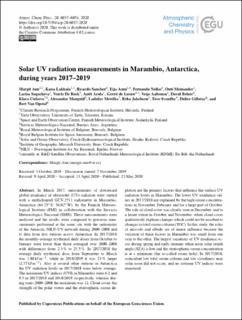| dc.contributor.author | Aun, Margit | |
| dc.contributor.author | Lakkala, Kaisa | |
| dc.contributor.author | Sanchez, Ricardo | |
| dc.contributor.author | Asmi, Eija | |
| dc.contributor.author | Nollas, Fernando | |
| dc.contributor.author | Meinander, Outi | |
| dc.contributor.author | Sogacheva, Larisa | |
| dc.contributor.author | De Bock, Veerle | |
| dc.contributor.author | Arola, Antti | |
| dc.contributor.author | de Leeuw, Gerrit | |
| dc.contributor.author | Aaltonen, Veijo | |
| dc.contributor.author | Bolsee, David | |
| dc.contributor.author | Cizkova, Klara | |
| dc.contributor.author | Mangold, Alexander | |
| dc.contributor.author | Metelka, Ladislav | |
| dc.contributor.author | Jakobson, Erko | |
| dc.contributor.author | Svendby, Tove Marit | |
| dc.contributor.author | Gillotay, Didier | |
| dc.contributor.author | Van Opstal, Bert | |
| dc.date.accessioned | 2020-06-12T07:27:29Z | |
| dc.date.available | 2020-06-12T07:27:29Z | |
| dc.date.created | 2020-06-10T15:47:21Z | |
| dc.date.issued | 2020 | |
| dc.identifier.citation | Atmospheric Chemistry and Physics. 2020, 20, 6037-6054. | en_US |
| dc.identifier.issn | 1680-7316 | |
| dc.identifier.uri | https://hdl.handle.net/11250/2657813 | |
| dc.description.abstract | In March 2017, measurements of downward global irradiance of ultraviolet (UV) radiation were started with a multichannel GUV-2511 radiometer in Marambio, Antarctica (64.23∘ S; 56.62∘ W), by the Finnish Meteorological Institute (FMI) in collaboration with the Servicio Meteorológico Nacional (SMN). These measurements were analysed and the results were compared to previous measurements performed at the same site with the radiometer of the Antarctic NILU-UV network during 2000–2008 and to data from five stations across Antarctica. In 2017/2018 the monthly-average erythemal daily doses from October to January were lower than those averaged over 2000–2008 with differences from 2.3 % to 25.5 %. In 2017/2018 the average daily erythemal dose from September to March was 1.88 kJ m−2, while in 2018/2019 it was 23 % larger (2.37 kJ m−2). Also at several other stations in Antarctica the UV radiation levels in 2017/2018 were below average. The maximum UV indices (UVI) in Marambio were 6.2 and 9.5 in 2017/2018 and 2018/2019, respectively, whereas during years 2000–2008 the maximum was 12. Cloud cover, the strength of the polar vortex and the stratospheric ozone depletion are the primary factors that influence the surface UV radiation levels in Marambio. The lower UV irradiance values in 2017/2018 are explained by the high ozone concentrations in November, February and for a large part of October. The role of cloud cover was clearly seen in December, and to a lesser extent in October and November, when cloud cover qualitatively explains changes which could not be ascribed to changes in total ozone column (TOC). In this study, the roles of aerosols and albedo are of minor influence because the variation of these factors in Marambio was small from one year to the other. The largest variations of UV irradiance occur during spring and early summer when noon solar zenith angle (SZA) is low and the stratospheric ozone concentration is at a minimum (the so-called ozone hole). In 2017/2018, coincident low total ozone column and low cloudiness near solar noon did not occur, and no extreme UV indices were measured. | en_US |
| dc.language.iso | eng | en_US |
| dc.rights | Navngivelse 4.0 Internasjonal | * |
| dc.rights.uri | http://creativecommons.org/licenses/by/4.0/deed.no | * |
| dc.subject | Trollobservatoriet | |
| dc.title | Solar UV radiation measurements in Marambio, Antarctica, during years 2017–2019 | en_US |
| dc.type | Peer reviewed | en_US |
| dc.type | Journal article | en_US |
| dc.description.version | publishedVersion | en_US |
| dc.rights.holder | © Author(s) 2020. | en_US |
| dc.source.pagenumber | 6037-6054 | en_US |
| dc.source.volume | 20 | en_US |
| dc.source.journal | Atmospheric Chemistry and Physics | en_US |
| dc.identifier.doi | 10.5194/acp-20-6037-2020 | |
| dc.identifier.cristin | 1814867 | |
| dc.relation.project | EC/H2020/730938 | en_US |
| dc.relation.project | Miljødirektoratet: * | en_US |
| dc.relation.project | Nordforsk: CRAICC | en_US |
| dc.relation.project | NILU: 105055 | en_US |
| cristin.ispublished | true | |
| cristin.fulltext | original | |
| cristin.qualitycode | 2 | |

